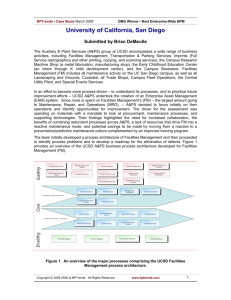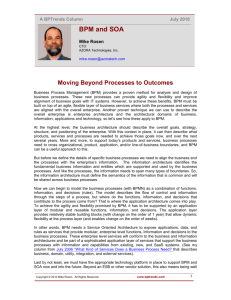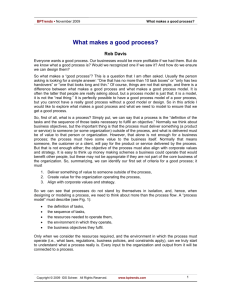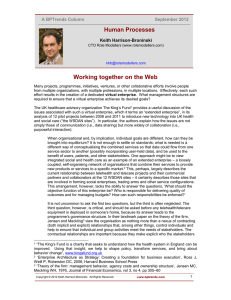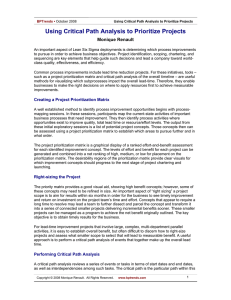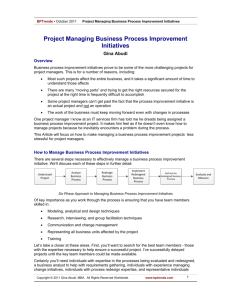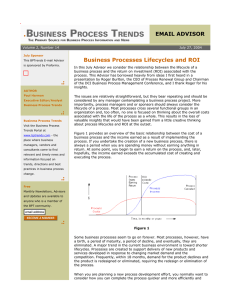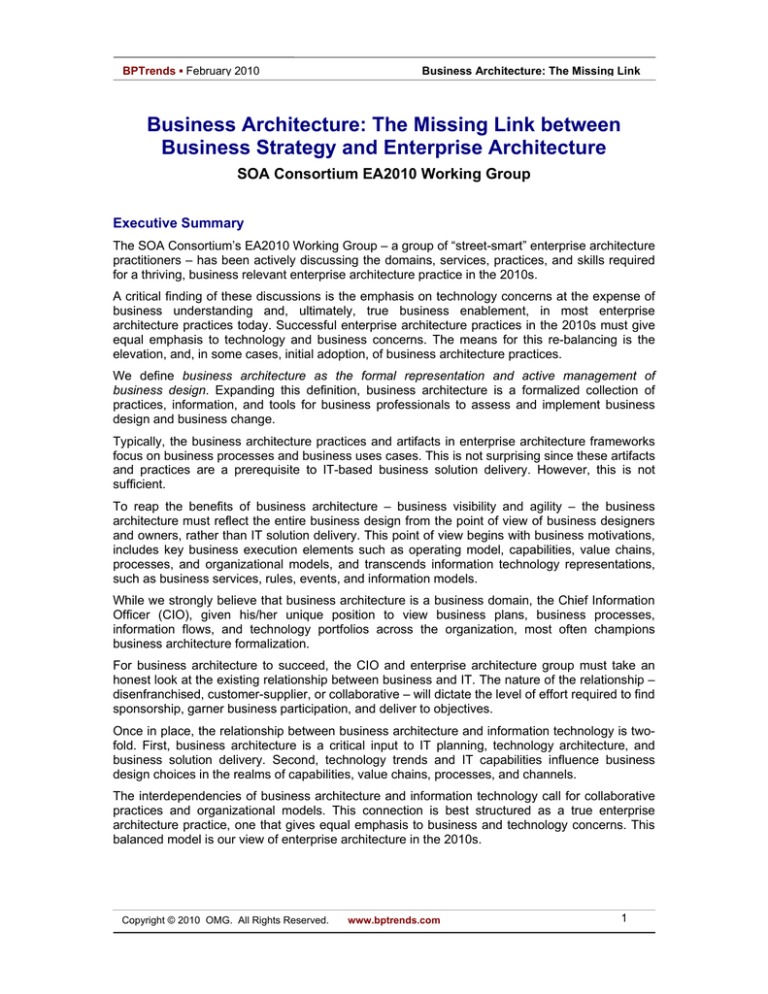
BPTrends ▪ February 2010
Business Architecture: The Missing Link
Business Architecture: The Missing Link between
Business Strategy and Enterprise Architecture
SOA Consortium EA2010 Working Group
Executive Summary
The SOA Consortium’s EA2010 Working Group – a group of “street-smart” enterprise architecture
practitioners – has been actively discussing the domains, services, practices, and skills required
for a thriving, business relevant enterprise architecture practice in the 2010s.
A critical finding of these discussions is the emphasis on technology concerns at the expense of
business understanding and, ultimately, true business enablement, in most enterprise
architecture practices today. Successful enterprise architecture practices in the 2010s must give
equal emphasis to technology and business concerns. The means for this re-balancing is the
elevation, and, in some cases, initial adoption, of business architecture practices.
We define business architecture as the formal representation and active management of
business design. Expanding this definition, business architecture is a formalized collection of
practices, information, and tools for business professionals to assess and implement business
design and business change.
Typically, the business architecture practices and artifacts in enterprise architecture frameworks
focus on business processes and business uses cases. This is not surprising since these artifacts
and practices are a prerequisite to IT-based business solution delivery. However, this is not
sufficient.
To reap the benefits of business architecture – business visibility and agility – the business
architecture must reflect the entire business design from the point of view of business designers
and owners, rather than IT solution delivery. This point of view begins with business motivations,
includes key business execution elements such as operating model, capabilities, value chains,
processes, and organizational models, and transcends information technology representations,
such as business services, rules, events, and information models.
While we strongly believe that business architecture is a business domain, the Chief Information
Officer (CIO), given his/her unique position to view business plans, business processes,
information flows, and technology portfolios across the organization, most often champions
business architecture formalization.
For business architecture to succeed, the CIO and enterprise architecture group must take an
honest look at the existing relationship between business and IT. The nature of the relationship –
disenfranchised, customer-supplier, or collaborative – will dictate the level of effort required to find
sponsorship, garner business participation, and deliver to objectives.
Once in place, the relationship between business architecture and information technology is twofold. First, business architecture is a critical input to IT planning, technology architecture, and
business solution delivery. Second, technology trends and IT capabilities influence business
design choices in the realms of capabilities, value chains, processes, and channels.
The interdependencies of business architecture and information technology call for collaborative
practices and organizational models. This connection is best structured as a true enterprise
architecture practice, one that gives equal emphasis to business and technology concerns. This
balanced model is our view of enterprise architecture in the 2010s.
Copyright © 2010 OMG. All Rights Reserved.
www.bptrends.com
1
BPTrends ▪ February 2010
Business Architecture: The Missing Link
Introduction
The SOA Consortium’s EA2010 Working Group – a group of “street-smart” enterprise architecture
practitioners – has been actively discussing the domains, services, practices, and skills required
for a thriving, business relevant enterprise architecture practice in the 2010s.
The major domains we identified are technology architecture, business architecture, projects
alignment, delivery, operations and measurement, and governance and enterprise architecture
management.
Although all are critical to enterprise architecture success, the team chose to focus on business
architecture because of the close ties to business-driven SOA success.
By “business-driven SOA,” we mean three things:
1. Creating a portfolio of services that represent capabilities offered by, or required of,
your organization. Those capabilities may represent business, information, or technology
concepts.
2. Composing or orchestrating those services along with events, rules, and policies into
business processes and solutions that fulfill business scenarios.
3. Working towards a business outcome. That “business outcome” could be cost and
complexity reduction via a rationalized IT portfolio. In other words, “business-driven”
doesn’t require a business person tapping you on the shoulder; it means executing for
business reasons.
As a starting point, the team needed to agree on a definition of business architecture. We defined
business architecture as the formal representation and active management of business design.
Expanding this definition, business architecture is a formalized collection of practices, information,
and tools for business professionals to assess and implement business design and business
change.
As stated above, the relationship between business architecture and information technology is
two-fold. First, business architecture is a critical input to IT planning, technology architecture, and
business solution delivery. Second, technology trends and IT capabilities influence business
design choices in the realms of capabilities, value chains, processes, and channels.
Figure 1. The Relationships between Business Architecture and Information Technology
Copyright © 2010 OMG. All Rights Reserved.
www.bptrends.com
2
BPTrends ▪ February 2010
Business Architecture: The Missing Link
The interdependencies of business architecture and information technology call for collaborative
practices and organizational models. This connection is best structured as a true enterprise
architecture practice, one that gives equal emphasis to business and technology concerns. Many
enterprise architecture initiatives today do not have a balanced approach, and technology views
dominate the perspective. The balanced model is our view of enterprise architecture in the 2010s.
Figure 2. A Balanced Enterprise Architecture Practice
We recognize that our view is just that, our view. We welcome feedback – real-world experiences,
and tips from fellow practitioners. Please see the summary on page 13 for details on how to
participate in the discussion.
Given the historical emphasis on the technology side of enterprise architecture, this discussionoriented paper delves into the business architecture aspect, sharing the team’s findings on the
following questions:
•
What comprises business architecture?
•
What is the purpose?
•
Who participates?
•
How do you make business architecture accessible?
•
How does business architecture facilitate business decision-making and change?
•
How do you keep business architecture current?
Before delving into our business architecture findings, we offer some enterprise architecture
context.
Enterprise Architecture Context
Over the years, IT has accumulated many types of architectural domains and corresponding
architecture disciplines to address each domain; e.g., IT has application architecture,
infrastructure architecture, security architecture, information architecture, and more. Enterprise
architecture has been broadly defined to encompass all of these architectural domains.
Depending on which expert you ask, the area of enterprise architecture may include, use, or
overlap with the newest architecture discipline: business architecture.
Most would agree that the field of enterprise architecture was officially established in 1987, with
the development of the Zachman Frameworki. Since then, various IT standards bodies,
government agencies, industry analyst groups, and enterprise practitioners have defined and
refined enterprise architecture. Three widely recognized definitions are from The Open Group’s
Architecture Framework (TOGAF)ii, the United States General Accounting Office (GAO)iii, and the
MIT Sloan Center for Information System Research (CISR)iv.
Copyright © 2010 OMG. All Rights Reserved.
www.bptrends.com
3
BPTrends ▪ February 2010
Business Architecture: The Missing Link
TOGAF describes enterprise architecture’s purpose as supporting the business “by providing the
fundamental technology and process structure for an IT strategy.” The GAO defines EA as “a
blueprint that describes an organization’s or a functional area’s current and desired state in both
logical and technical terms, as well as a plan for transitioning between the two states.” MIT’s
CISR defines EA as “the organizing logic for business processes and IT infrastructure reflecting
the integration and standardization requirements of the firm’s operating model.” While the wording
varies, the underlying common themes are
a) enterprise architecture exists to optimize and align IT resources with business
goals/objectives,
b) enterprise architecture is manifested as a set of inter-related models, and
c) these models are characterized using a prescriptive metamodel, such as Zachman’s
original work or one of CISR’s four operating modelsv.
For an IT organization to thrive, and for an EA program to succeed, it must understand the
business it supports. Thus, EA frameworks and definitions, including the above three, incorporate
some form of business architecture.
Figure 3. Business Processes and Use Cases are IT Prerequisites
Typically, the business architecture practices and artifacts in enterprise architecture frameworks
focus on business processes and business uses cases. This is not surprising, since these
artifacts and practices are a prerequisite to IT-based business solution delivery.
However, this is not sufficient. To reap the benefits of business architecture – business visibility
and agility – the business architecture must reflect the entire business design from the point of
view of business designers and owners, rather than IT solution delivery.
Business Architecture Overview
What is Business Architecture?
The EA2010 working group defines business architecture as the formal representation and active
management of business design. Expanding this definition, business architecture is a formalized
collection of practices, information, and tools for business professionals to assess and implement
business design and business change.
Business Design. Business architecture must encompass the entire business design from the
business designers’ and owners’ points of view. This begins with business motivations, includes
key business execution elements – such as operating model, capabilities, value chains,
processes, and organizational models – and transcends information technology representations,
such as business services, rules, events, and information models.
Solely by the fact that they exist, all businesses have a business design. That design may be
intended, explicit, and effective, or may be an implicit amalgamation of past actions and
underperforming. Business architecture is the formal representation of business design, with the
Copyright © 2010 OMG. All Rights Reserved.
www.bptrends.com
4
BPTrends ▪ February 2010
Business Architecture: The Missing Link
intent to apply the business architecture information and supporting techniques to optimize the
business design, and to facilitate ongoing change.
Formal Representation. Business architecture is formally represented via a variety of artifacts,
including business motivation models, capability maps, value chain maps, process models, policy
documents, organization charts, and product catalogs. The techniques used to produce and
manage these artifacts vary by situation. Organizations focused on eliminating waste may employ
Lean practicesvi, while organizations focused on competitive advantage may employ value chain
analysis.
Active Management. For ease of accessibility, the business architecture artifacts should be
managed in a repository. While business professionals are the primary creators and full owners,
of these artifacts, IT is typically the caretaker of the business architecture environment, including
underlying repository, information storage, user access, and, optionally, business performance
integration.
Why Business Architecture?
Organizations need reliable and cost effective operations. Business architecture provides the
mechanism to clearly illuminate how strategy, processes, business structure, and staff can best
be utilized to deliver reliable and cost effective operations. With this clarity, business can enable
new functions and services with the right resources and technology, effectively and efficiently.
Technology enablement is key to the majority of new functions and services. Business
architecture helps organizations define the technology requirements and capabilities clearly,
yielding IT plans and projects that align with business priorities and goals.
The following scenarios demonstrate how business architecture serves to improve operations and
the alignment of technology to business needs:
Focus on value to the organization and the customer: Business architecture can
help organizations analyze key value chains. Value chains are the functions and services that
yield the most economic value for the organization and provide the organization’s customers with
the necessary services, products, and information to maintain loyalty. Value chains are the
foundation of an organization’s ability to compete and grow in dynamic market conditions. Clearly,
understanding these value chains will help remove roadblocks, reduce risks, and improve
efficiency in processes and technology, resulting in better bottom line results and customer
loyalty.
Find synergies in generic processes: By highlighting the steps of business processes
and their dependencies, organizations can eliminate duplicate operations, processes, and
technologies across business units and functions. By consolidating and standardizing common
operations, organizations can redirect budget, technology, and staff to focus on the organization’s
value-chains.
Provide the blueprint for business transformation: Many organizations are dealing
with disruptive changes in markets and customer needs. They must make rapid and significant
changes to remain competitive and to deliver goods and services that meet the new market and
customer requirements. Business architecture provides the methods to analyze and plan how the
organization should morph its structure, processes, technology, and staff.
Who Does Business Architecture?
According to the Business Architects Associationvii, business architecture is “performed by crossorganizational generalists who possess professional skills for transforming corporate strategy into
business designs that enable corporations to increase market share, profit margins, and flexibility,
while reducing risk.”
Copyright © 2010 OMG. All Rights Reserved.
www.bptrends.com
5
BPTrends ▪ February 2010
Business Architecture: The Missing Link
While we strongly believe that business architecture is a business thing, the most likely origin of a
business architecture practice is within IT. Our thinking revolves around the silo-like nature of
business, versus the cross-enterprise perspective of IT. Obviously, the danger of this approach is
that the business may be skeptical about the value of IT or, worse, refuse to participate.
As such, each enterprise architecture group must take an honest look at the existing relationship
between IT and the business before embarking fully on a business architecture effort. The nature
of relationship will dictate the level of effort required in finding the correct champion, garnering
business participation, and delivering to objectives.
A key to business architecture success is the business IQ of the enterprise architecture team.
Enterprise architects must be equally comfortable with both business and IT executives. He/she
must possess business acumen to translate business partner strategies to IT groups as well as
possess IT acumen to translate IT strategies to business groups.
As the enterprise architecture team strives to reach the business-alignment goal, other additional
benefits accrue: appropriate levels of integration between business applications and data,
improved IT delivery, lower IT costs, lower IT complexity, and, perhaps most importantly, lower IT
operational risk. That is, IT becomes better, faster, cheaper, which clearly is of significant value to
the business.
Business Architecture in Action
Google Your Business
Businesses are constantly exploring new strategies to increase efficiency or find new sources of
revenues by introducing new products or services or by making acquisitions. The impact of
implementing these strategic changes cannot be left to chance. Having access to business
process definitions, organizational and other business information and their interrelationships can
greatly enhance the chance of success.
In addition to strategic change, business may also need business architecture information for
day-to-day activities to streamline operations or identify optimization opportunities, such as in the
supply chain.
One of the primary value propositions of a business architecture practice is to facilitate change.
Having accurate information at the fingertips of executives, line managers, and process owners
facilitates change. The nature of information required will vary by the need of the consumer of
business architecture information. For example, a CFO might be interested in understanding the
costs associated with various business processes. Sales and marketing managers might want to
know all about their customers and processes associated with managing customers.
We envision a mechanism by which business stakeholders can quickly search the business
architecture repository to come up with answers needed to meet the information needs of
business stakeholders. A keyword-based search should yield
•
Artifacts in order of relevance
•
Links to related artifacts
•
Fact based answers
This search mechanism must apply policies to govern access to sensitive information.
Copyright © 2010 OMG. All Rights Reserved.
www.bptrends.com
6
BPTrends ▪ February 2010
Business Architecture: The Missing Link
Business Architecture as IT Input
Figure 4. Business and IT Planning, Architecture and Delivery Interdependencies
With a business architecture there is a single, shared vision across the enterprise that informs
every employee who their customers are, the value the enterprise provides those customers, and,
at a high level, how that value is created, sold, and delivered to those customers. Strategic
objectives are turned into goals, strategies, and measures, and their impact on the daily operation
of the enterprise is understood and anticipated. Processes, activities, and systems are created to
support the business goals and business architecture.
As the business environment changes, the enterprise is able to respond with agility, and
everyone clearly understands the necessary organizational, skill set, process, and activity and
system changes needed to meet these new challenges.
Keeping your Business Architecture Current
Business Architecture is only as useful as the information contained in it; therefore, governance
processes must be established to ensure that business design changes and supporting business
solution implementations are reflected in the business architecture repository. In addition, metrics
should be established and tracked regarding the use of business architecture information.
In a mature business architecture practice, business analysis, design, and solution delivery
processes would integrate to the business architecture repository, providing access to critical
business design information and capturing all considered, pending, and implemented changes.
For detailed insights on the management and evolution of business architecture information, we
recommend reviewing Levels 4 and 5 – Quantitatively Managed and Optimizing – of the
Capability Maturity Model (CMMi)viii.
Copyright © 2010 OMG. All Rights Reserved.
www.bptrends.com
7
BPTrends ▪ February 2010
Business Architecture: The Missing Link
Artifacts and Industry Examples
As mentioned throughout this paper, there are a variety of business architecture techniques,
artifacts, and notation languages. Examples of techniques include Six Sigma, Lean, Value Chain
Analysis, and Rummler Brache. Corresponding artifacts include SIPOC diagrams, value stream
maps, value chain diagrams, and business environment models. Popular notations include
BPMN™ and UML®.
A model we find useful is Nick Malik’s Enterprise Business Motivation Model (EBMM)ix. The
EBMM contains seven core models, covering these concepts: Influencer, Driver, Business Unit,
Business Unit Capability, Business Model, Directive, Business Process, and Assessment. The
compelling aspect of the EBMM is the traceability from business motivation to managed IT
service.
Enterprise Business Motivation Model (EBMM)x
Figure 5.
Establishing Business Architecture Practice
Starting Points/Triggers
The initial scope and activities included within business architecture will depend in part on which
group in the organization initiated the interest in business architecture: Did it come from the
business itself (senior management)? Is it an IT-driven or IT-centric effort, meant to provide an
underpinning to enterprise architecture? Or is it a joint effort to achieve better alignment between
IT and the business?
The following activities may be part of the mission of business architecture:
Copyright © 2010 OMG. All Rights Reserved.
www.bptrends.com
8
BPTrends ▪ February 2010
•
•
•
•
•
•
Business Architecture: The Missing Link
Illustrating how the business works, i.e., inventorying the business capabilities of the
enterprise. This can lead the executive team to reorganize in order to clarify who is in
charge of each capability.
Identifying gaps in the organization, which could result in organization changes, but can
also help determine what acquisition or merger strategies should be pursued, and who
are the most appropriate M&A targets, in order to fill the gaps.
Identifying the top end-to-end processes of the organization (e.g., “opportunity to cash,”
“hire to retire,” “sourcing to delivery,” etc.). This can lead to better assignments of
responsibilities to parts of the organization (so that responsibility is less diluted, or
changes less often, as these processes unfold), or it can be a prerequisite to business
process management, or at least lead to a prioritization of business process improvement
efforts. Often, the simple identification and documentation of these end-to-end processes,
and the awareness of which parts of the organization contribute to them at different
stages, helps combat the silo effect by making different groups aware of the need to
cooperate with each other.
Helping management decide which capabilities must be provided internally (and nurtured
appropriately), and which ones can be outsourced.
Mapping the business capabilities to the business systems managed by IT in order to
identify and resolve inconsistencies, duplications, or gaps.
Establishing metrics to measure the performance of the organization. These metrics may
in turn be used to influence the compensation of senior management, aligning a bonus
structure with actual operational excellence.
Overcoming the Business Architecture Branding Problem
We have found that business architecture suffers from a positioning issue, or a “branding
problem,” if the reader prefers that image. The issue stems from the fact that describing the
design of the business using the word “architecture” typically stems from the enterprise
architecture mindset, which originated in IT organizations, as a way to formalize the connections
between applications, and between those and the computer infrastructure of the organization.
Seen in this light, business architecture appears to be an idea or approach that IT people would
like to foist on unsuspecting business folks who were busy doing their work until the CIO came
along and disrupted their game.
A variant of this issue is when the executive team is very consciously engaged in “designing the
business”: defining and owning the vision and the mission statement, determining and updating
the key strategies, fine-tuning or redoing the organization, targeting acquisitions and divestitures,
etc. Even if they like the phrase “business architecture,” their reaction may be “Well, that is what
we’ve been doing, so who are you to come along and tell us how we’re supposed to do our
work?”
A situation that may, unfortunately, be both the worst possible and the most probably is this: The
business does not explicitly take care of business architecture, but they don’t want anyone else to
come and tell them what it is (or that they should do it). In this all-too-common scenario,
management reflection and actions about the vision, mission, strategies, and organization
happen reactively, after something went wrong, and are conducted by one of the executives
without formal training on this activity and without a formal blueprint.
How can one solve this “branding issue”? One way is to realize that results speak louder than
concepts, and that case studies from other organizations can carry a lot of weight. This is a
chicken-and-egg situation since compelling case studies of successful business architecture
efforts are still few and relatively unspecific. However, bringing available case studies to the
attention of senior management should be a key piece of this puzzle.
Copyright © 2010 OMG. All Rights Reserved.
www.bptrends.com
9
BPTrends ▪ February 2010
Business Architecture: The Missing Link
Equally important is the perception of the person who brings up this concept to the executives. If
a CIO who is seen as the “plumber-in-chief” of the company’s infrastructure raises the need for
business architecture, this will probably fail. But if the CIO is a peer who is trusted for her or his
knowledge of methodologies and processes, then the suggestion is much more likely to be heard.
Business Architecture and Related Topics
Business Architecture and SOA
The connection point between service-oriented architecture (SOA) and business architecture was
the starting point of the EA2010 journey. As experienced SOA practitioners, we recognized the
importance of defining services that reflected business capabilities and enterprise information
needs, as opposed to defining services that mimicked technology assets.
A point of discussion though, was on service analysis approaches that would result in welldefined, cohesive, relevant, business services. As we exchanged success and failure stories, we
discovered that organizations performing true business architecture and analysis techniques,
such as capability mapping, value chain analysis, and enterprise information modeling, were far
more successful than organizations performing solutions and systems analysis techniques.
Business Architecture and BPM
In the “starting points” mentioned earlier, we said that “inventorying the business capabilities” and
“identifying the top end-to-end processes” were two key activities that are part of business
architecture. This implies a strong connection between business architecture and business
process management, or BPM. Yet, as the list above also implies, BPM is not the only thing a
business architect does.
BPM is a method or a tool that contributes to business architecture. Enterprise architects may see
BPM as a way to rationalize business systems, and CFOs may see BPM as a way to find
opportunities for headcount reduction through process simplification. Business architecture views
BPM as something that implements the well-known principle that “you can’t improve what you
can’t measure,” or perhaps Einstein’s admonition to “spend 90% of the time defining the problem,
and 10% of the time working on the solution.” Documenting the “as-is” processes of the
enterprise, using BPM techniques (and, potentially, BPM software), allows a business architect to
identify and demonstrate
•
•
•
•
Areas where responsibilities are clear and key functions are performed efficiently
Areas where processes and responsibilities are unclear
Orphaned area – A repeatable process may exist, but no one owns it
Gaps in the organization’s skills – which could be solved by activities ranging from
staffing a missing position to making an acquisition.
While the key skills of the business architect are to analyze the business and design changes to
make it operate better, BPM is therefore a key competency too. BPM will provide the visual
documentation of key processes that may elicit from executives a surprised “Oh, so THIS is what
we do?” response, and will also usually result in some pragmatic, short-term improvements by the
owners of the documented processes.
Summary and Discussion Questions
In this discussion-oriented paper, we articulated our belief that a business architecture practice is
a must-have component of thriving, business relevant enterprise architecture practice in the
2010s.
After presenting our definition of business architecture – the formal representation and active
management of business design – we shared our findings on the following questions:
Copyright © 2010 OMG. All Rights Reserved.
www.bptrends.com
10
BPTrends ▪ February 2010
•
•
•
•
•
•
Business Architecture: The Missing Link
What comprises business architecture?
What is the purpose?
Who participates?
How do you make business architecture accessible?
How does business architecture facilitate business decision-making and change?
How do you keep business architecture current?
In addition, wearing our enterprise architect hats, we discussed the relationship of business
architecture and several critical business and technology constructs, including business-IT
alignment, business process management (BPM), service-oriented architecture (SOA, and
business solution delivery.
Discussion Questions
As mentioned in the opening, we recognize that our view is just that, our view. We welcome
feedback, real-world experiences, and tips from fellow practitioners, business architecture
consultants, and related solution providers.
Specifically, we would appreciate insights on the following:
1. Do you have suggestions and/or experience in making a business architecture practice
actionable?
2. How have you resolved/overcome the business architecture branding problem?
3. Which business architecture techniques and artifacts do you find helpful?
4. How have you made your business accessible to business analysts, designers, and
decision-makers?
Please share your feedback at our blogxi, or via email to EA2010@soa-consortium.org
_____
Authors
The key themes in this paper originated during EA2010 working group calls over the course of
2009. As such, we would like to thank all SOA Consortium members and guests who contributed
to our discussions.
The EA2010 core team jointly authored the paper. Core team members:
Claude Baudoin, Principal Consultant, cébé IT and Knowledge Management
Burt Covnot, SVP, Enterprise Architecture, Bank of America
Ashok Kumar, Director - Services Architecture, Information Technology at Avis Budget
Group
- Ken LaCrosse, IT Architect, Raleys
- Robert Shields, Senior Market Manager, Enterprise Architecture, IBM Rational Software
Editor: Brenda M. Michelson, SOA Consortium and Elemental Links
-
References
i
http://www.zachmaninternational.com/index.php/the-zachman-framework
http://www.opengroup.org/togaf/
iii
http://www.gao.gov/products/GAO-06-831 and http://www.gao.gov/products/GAO-08-519
iv
http://mitsloan.mit.edu/cisr/
v
http://www.architectureasstrategy.com/book/eas/
ii
Copyright © 2010 OMG. All Rights Reserved.
www.bptrends.com
11
BPTrends ▪ February 2010
Business Architecture: The Missing Link
vi
See: http://en.wikipedia.org/wiki/Lean_manufacturing, http://en.wikipedia.org/wiki/Lean_services and
http://en.wikipedia.org/wiki/Lean_software_development
vii
http://baainstitute.com/
viii
http://www.sei.cmu.edu/cmmi/index.cfm
ix
For
a
description
of
the
EBMM,
see
http://msdn.microsoft.com/enus/architecture/aa699429.aspx.
x
xi
Diagram source: http://i.msdn.microsoft.com/aa699429.art2fig10(en-us,MSDN.10).jpg
http://blog.soa-consortium.org
Copyright © 2010 OMG. All Rights Reserved.
www.bptrends.com
12

